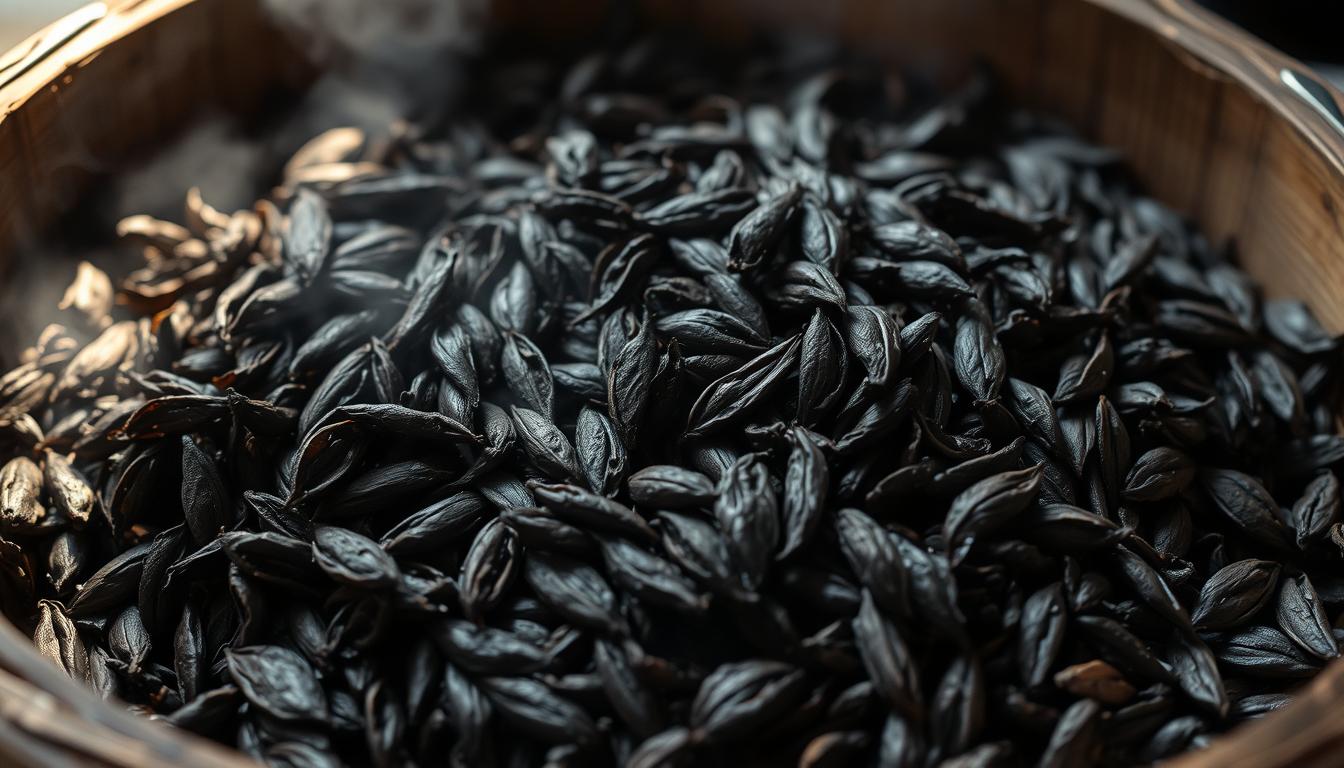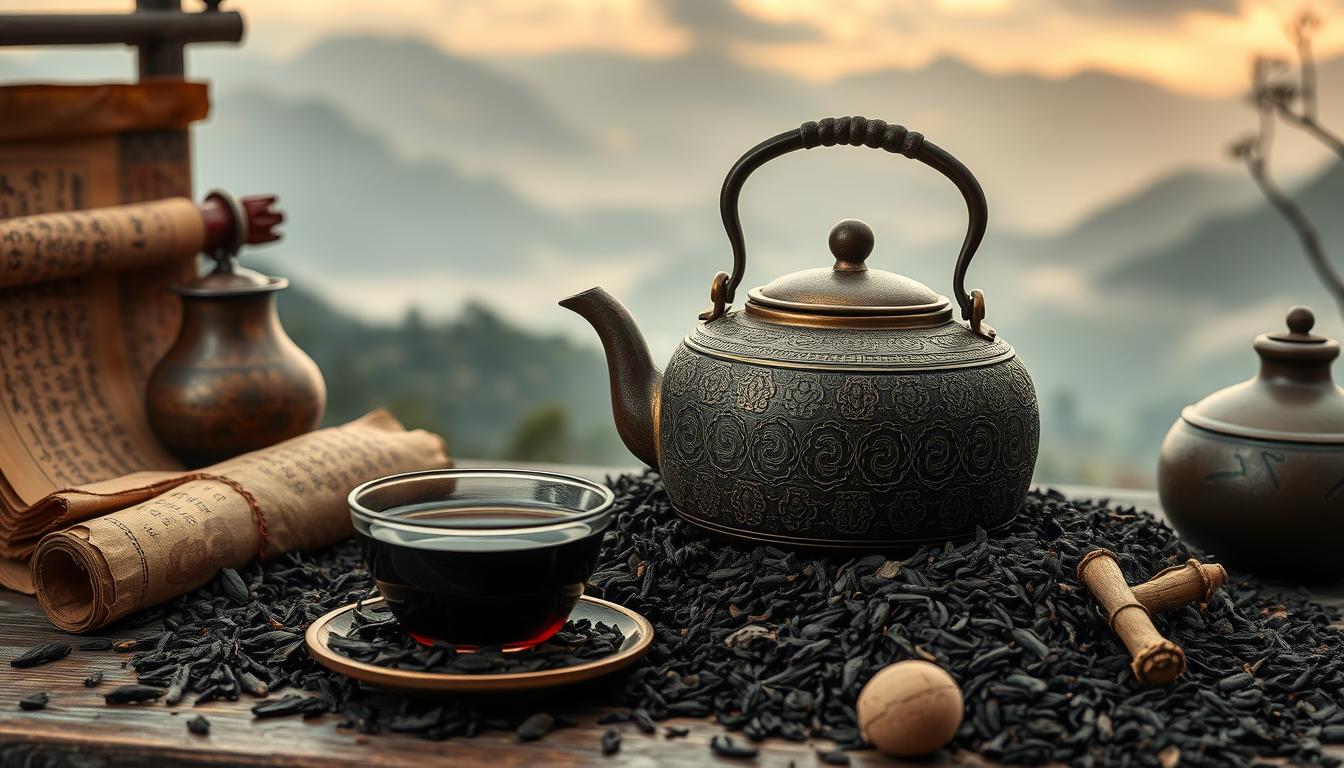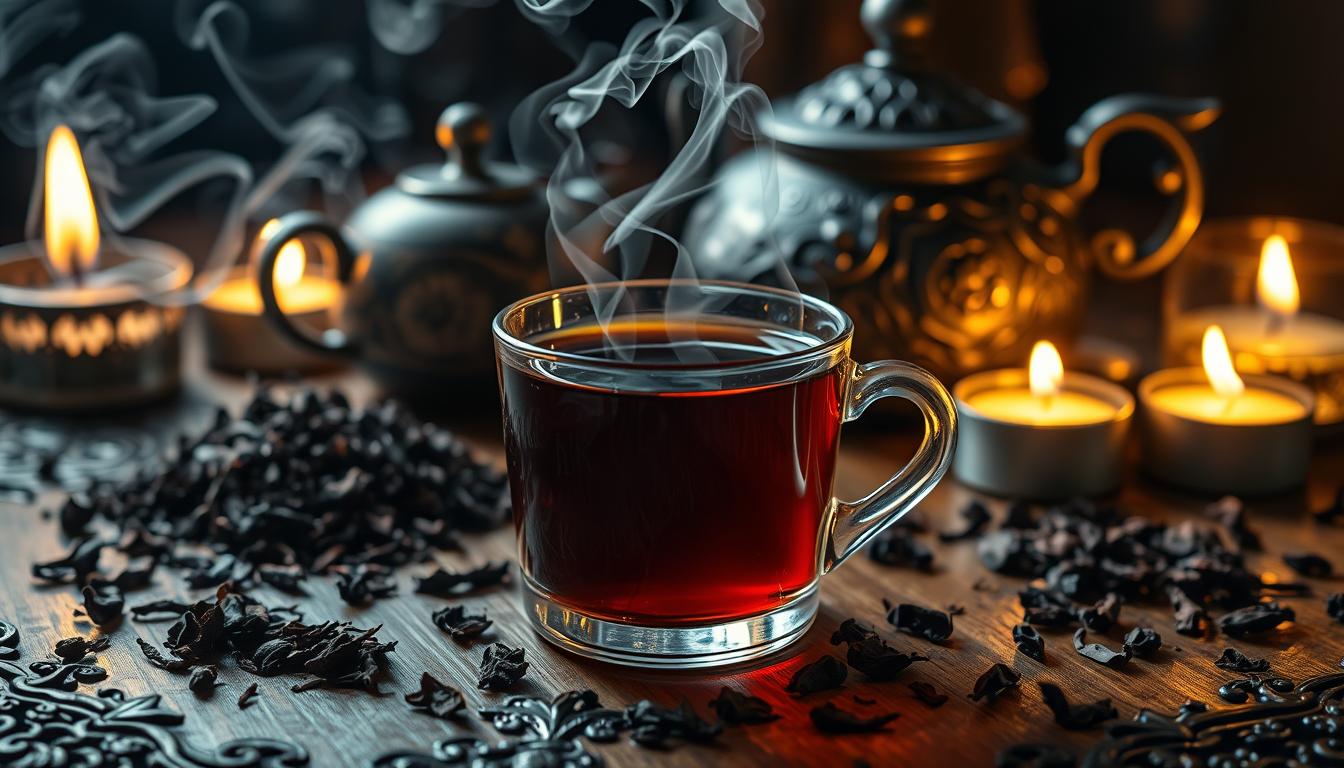What makes dark tea so special and loved by tea lovers? Is it the unique taste, the health perks, or its long history? Let’s dive into dark tea, its types, and why it’s a favorite among tea fans.
Dark tea’s roots go back to ancient China. It’s a bold and magical drink that stands out from other teas. From its start to its many types and health benefits, there’s a lot to learn about this intriguing drink.
Key Takeaways
- Dark tea is a fermented tea with a unique flavor and many health benefits.
- The introduction to dark tea is a great starting point for those looking to explore the world of tea.
- Dark tea benefits include antioxidant properties, digestive health support, and mental clarity.
- There are various types of dark tea, each with its own distinct characteristics and flavor profiles.
- Understanding the basics of dark tea is essential to appreciating its complexity and versatility.
- Dark tea is a great choice for those looking to try something new and exciting in the world of tea.
Introduction to Dark Tea
Dark tea is a type of tea that’s fermented, giving it a unique flavor and aroma. It’s different from other teas because of this fermentation process. To understand dark tea, we need to look at its characteristics and how it stands out.
The fermentation process is key to dark tea’s taste and nutritional value. It involves microorganisms breaking down the tea leaves. This makes dark tea distinct from other teas.

Dark tea is known for its earthy, rich flavor. This flavor comes from the fermentation process, which can last from months to years. This process not only enhances the flavor but also the nutritional content, making it a favorite among tea lovers.
What is Dark Tea?
Dark tea is a fermented type of tea with a unique taste and aroma. The fermentation process breaks down the tea leaves, creating its distinctive flavor.
How Dark Tea Differs from Other Teas
Dark tea is different because of its fermentation process. This process gives it a unique flavor and nutritional content. Its earthy, rich taste is a result of this fermentation.
The Origins and History of Dark Tea
Dark tea has a rich history that goes back centuries. It started in Chinese tea culture. This history shows China’s deep heritage and its big role in the tea trade.
Dark tea is very important in Chinese tea ceremonies. It’s a key part of their traditions. Chinese tea culture values the art of making tea, and dark tea is no different. Its unique taste and health benefits have made it very valuable in the tea trade.
Tracing the Roots: The Birth of Dark Tea in China
Dark tea first came from Yunnan province in China during the Tang Dynasty. It was loved for its special flavor and smell. These came from a unique fermentation process. As the tea trade grew, dark tea went to other parts of Asia, becoming a big part of local tea cultures.
The Cultural Significance of Dark Tea in Chinese Tea Ceremonies
In Chinese tea ceremonies, dark tea is a sign of respect and welcome. It’s made and served with great care in a traditional setting. This shows how important tea is in Chinese culture, seen as a symbol of harmony and balance.

How Dark Tea Spread Across Asia and the World
As the tea trade grew, dark tea went to places like Japan, Korea, and India. It came through trade and cultural exchange, where it was welcomed into local traditions. Now, dark tea is loved all over the world, known for its unique taste and cultural importance.
| Country | Introduction of Dark Tea |
|---|---|
| China | Tang Dynasty |
| Japan | 17th century |
| Korea | 18th century |
| India | 19th century |
The Types of Dark Tea
Dark tea is a wide range of teas, each with its own special taste and making process. Pu-erh tea and liu bao tea are two of the most famous kinds. They stand out because of their unique flavors and how they’re made.
Exploring dark tea means learning about its different kinds. Pu-erh tea is known for its earthy taste. Liu bao tea is loved for its smooth flavor. These tastes come from how each tea is made and fermented.
Pu-erh Tea: The Most Famous Dark Tea
Pu-erh tea comes from China’s Yunnan province. It’s famous for its rich, earthy flavor. This flavor comes from a special fermentation process.
Liu Bao Tea: The Hidden Gem of Dark Teas
Liu bao tea is not as well-known but is gaining fans. It has a smooth, mellow taste. This tea is made in a unique way, making it both soothing and refreshing.
Other dark teas like miang and heicha also have unique tastes and making methods. They’re great for those who want to learn more about dark tea.
| Type of Dark Tea | Origin | Flavor Profile |
|---|---|---|
| Pu-erh Tea | Yunnan, China | Earthy, mellow |
| Liu Bao Tea | Guangxi, China | Smooth, delicate |
The Process of Making Dark Tea
Dark tea production is a detailed and slow process. It’s different from other teas because of its fermentation and aging steps. These steps can take months to years, depending on the tea type. They give dark tea its special taste and smell.
After fermentation, the tea ages. This step makes the tea’s flavor and health benefits better. Aging is key for dark tea, as it brings out its earthy and smooth taste. Aging time varies but is usually several years.
The Complex Fermentation Process of Dark Tea
The fermentation of dark tea is intricate. It involves microorganisms like bacteria and fungi on the tea leaves. This process can last from months to years, based on the tea type. It’s done in a controlled setting, with careful monitoring of temperature and humidity.
How Post-Fermentation Enhances Flavor
After fermentation, the tea is dried and aged. This aging can last for years, enhancing its flavor and aroma. The post-fermentation step is vital for dark tea’s unique taste.
The Role of Aging in Dark Tea
Aging is crucial in dark tea production. It allows the tea to develop its distinct flavor and aroma. Aging time varies but is usually several years. The tea is kept in a cool, dry place during this time.
Several factors influence dark tea’s aging:
- Temperature: Cooler storage slows aging, while warmer storage speeds it up.
- Humidity: Higher humidity quickens aging, while lower humidity slows it.
- Light: Direct sunlight speeds up aging, while dark storage slows it.
In summary, making dark tea is a complex and slow process. It involves fermentation and aging. These steps are essential for dark tea’s unique taste and aroma.
The Flavor Profile of Dark Tea
Dark tea is known for its rich, earthy taste. This taste can change a lot based on where it’s made and how. It often has notes of earth, wood, and fruit, making it a complex drink.
Compared to other teas, dark tea has a smooth and mellow taste. This taste can be strong or light, depending on the tea.
The place where dark tea is made greatly affects its flavor. For example, teas from Yunnan, China, are earthy and mild. Teas from Guangxi, China, are fruitier and stronger. Over time, some dark teas get smoother and more complex.
- Earthy and woody notes
- Fruity and floral undertones
- Smooth and mellow texture
- Robust and complex flavor profile
The place where dark tea is made really shapes its taste. This is why tea lovers often look for teas from different places. They want to try the many flavors dark tea can have.
The Health Benefits of Dark Tea
Dark tea is becoming more popular for its unique taste and health perks. It’s packed with antioxidants, which help fight off free radicals and lower disease risks. It also boosts digestive health by improving the gut microbiome.
The antioxidants in dark tea fight off free radicals, which harm cells and lead to aging and diseases. This makes dark tea a great choice for a healthy diet. It supports overall health and wellbeing. Dark tea also has prebiotic properties, aiding in the growth of good gut bacteria.
Powerful Antioxidants: Protecting Your Body from Free Radicals
Dark tea is full of antioxidants like polyphenols and flavonoids. These help protect the body from oxidative stress. They reduce inflammation and improve health, making dark tea a smart choice for wellbeing.
Boosting Digestive Health with Dark Tea
Dark tea also benefits digestive health. Its prebiotic properties support the growth of good gut bacteria. This improves digestion and lowers digestive disorder risks.
Some key benefits of dark tea for digestive health include:
- Improved digestion and reduced symptoms of irritable bowel syndrome
- Increased growth of beneficial gut bacteria
- Enhanced immune system function
Dark tea is a nutritious and tasty addition to a healthy diet. It offers many health benefits, including antioxidants and digestive health perks.
How to Brew Dark Tea
Brewing dark tea is an art that needs attention to detail. This includes the right water temperature and steeping time. To enjoy the unique flavors of dark tea, knowing the best brewing conditions is key. The ideal water temperature for brewing dark tea is between 200°F and 212°F. This temperature helps extract the complex flavors and aromas of the tea.
The steeping time for dark tea is usually 3 to 5 minutes. But, it can change based on the type of dark tea and your taste. For example, some dark teas might need a shorter steep to avoid bitterness. Others might need a longer steep to fully enjoy their flavor.
The Best Water Temperature for Dark Tea
The water temperature is very important in brewing dark tea. It can change the flavor and aroma of the tea. Water that’s too hot can burn the tea leaves, making it bitter. On the other hand, water that’s too cold might not bring out the tea’s full flavor.
Ideal Steeping Time: How Long Should You Brew Dark Tea?
The steeping time is also key in brewing dark tea. It can affect the flavor and aroma. Here are some general guidelines for steeping dark tea:
- Steep for 3 minutes for a light and refreshing flavor
- Steep for 5 minutes for a full-bodied and complex flavor
Tips for Enjoying Dark Tea: From Fresh to Aged Varieties
To fully enjoy dark tea, using the right teapot and brewing technique is important. Here are some tips for enjoying dark tea:
- Use a teapot made from clay or ceramic to bring out the full flavor of the tea
- Experiment with different steeping times and water temperatures to find your perfect cup
Dark Tea and Food Pairings
Dark tea pairings offer a wide range of exciting options. Pu-erh tea, in particular, pairs well with many foods. In traditional Chinese cuisine, dark tea is often enjoyed with dim sum. This classic combination highlights the tea’s ability to enhance delicate flavors.
Here are some dark tea pairing suggestions:
- Pair pu-erh tea with cheese, such as cheddar or gouda, to balance its earthy flavor
- Combine dark tea with spicy dishes, like Szechuan hot pot, to enhance its bold flavor
- Enjoy dark tea with sweet treats, like chocolate or fruit, to bring out its subtle sweetness
Exploring traditional pairings, like dark tea with dim sum, is also a good idea. The key is to find balance between the tea’s flavor and the food’s. By trying different pairings, you can find new ways to enjoy dark tea.
- Pair pu-erh tea with roasted meats, like duck or pork, for a savory and satisfying combination
- Combine dark tea with steamed vegetables, like broccoli or carrots, for a light and refreshing pairing
- Enjoy dark tea with nuts, like almonds or walnuts, for a crunchy and flavorful snack
The world of dark tea pairings is vast and exciting. Whether you like traditional Chinese pairings or modern Western options, there’s something for everyone.
| Tea Type | Food Pairing | Flavor Profile |
|---|---|---|
| Pu-erh Tea | Dim Sum | Earthy, mellow |
| Dark Tea | Spicy Dishes | Bold, savory |
| Pu-erh Tea | Cheese | Earthy, creamy |
The Cultural Importance of Dark Tea
Dark tea is deeply rooted in Chinese and Asian traditions. It’s a key part of the Chinese tea tradition, loved for its unique flavor and aroma. In traditional Chinese medicine, dark tea is used to promote health and well-being.
Dark tea plays a big role in ceremonies and rituals. For example, in Chinese weddings, it’s served to symbolize unity and harmony. In business meetings, it shows respect and hospitality. High-quality dark teas are also seen as luxury items, cherished by connoisseurs.
- Its use in traditional Chinese medicine as a medicinal tea
- Its significance as a luxury item and symbol of heritage
- Its role in promoting health and well-being
The dark tea culture is rich and complex. It reflects the history and values of Chinese and Asian traditions. By understanding this culture, we can see the importance of dark tea in the world of tea.
Dark Tea vs. Other Teas
When we talk about dark tea comparison, it’s key to see how it differs from other teas. Dark tea is set apart by its unique fermentation process. This process creates its distinct flavor and aroma, loved by specialty tea fans.
Dark tea has a richer, earthier taste compared to other teas. This is because of its longer fermentation time. Green tea is light and refreshing, while black tea is stronger and bitter. Oolong tea has a complex taste, blending floral and fruity notes.
- Flavor profile: Dark tea is known for its rich, earthy flavor, while green tea is light and refreshing, and black tea is strong and bitter.
- Fermentation process: Dark tea undergoes a longer fermentation process, which gives it its unique flavor and aroma.
- Oxidation level: Dark tea is more oxidized than other types of tea, which affects its flavor and color.
Dark tea is a unique and tasty addition to the specialty tea world. Its distinct taste and aroma win over tea lovers. Plus, its health benefits make it a great choice for a healthy drink.
Conclusion
Exploring dark tea has shown us its rich history and health benefits. From Pu-erh to Liu Bao, dark tea offers a unique taste. It’s perfect for both tea lovers and newcomers.
Dark tea’s flavors are complex and evolving. It’s valued in Asian cultures for its taste and health benefits. This makes it stand out in the tea world.
Dark tea is a special part of the tea world. It has a rich history and complex flavors. It’s a journey worth taking for tea lovers.

